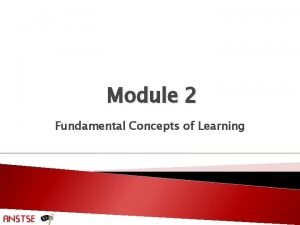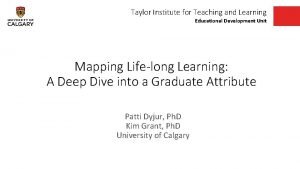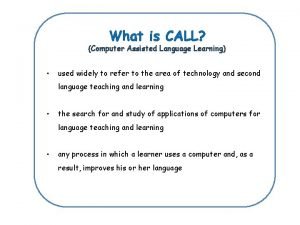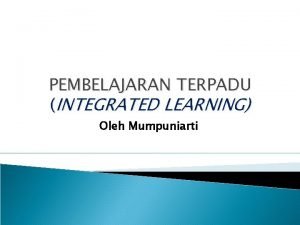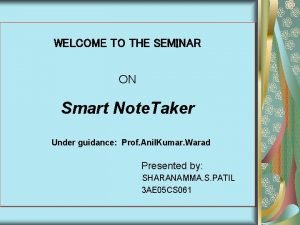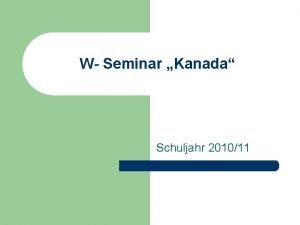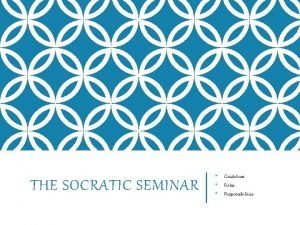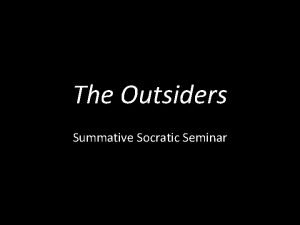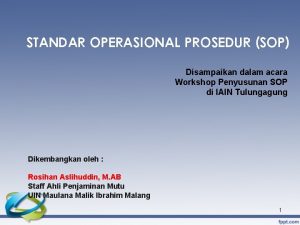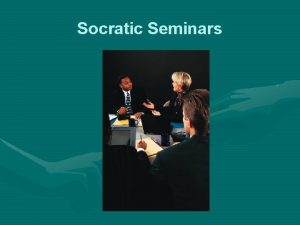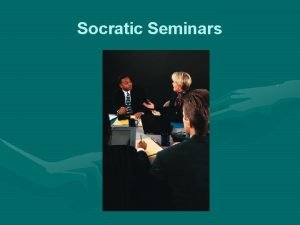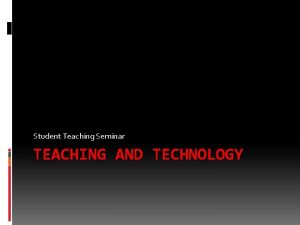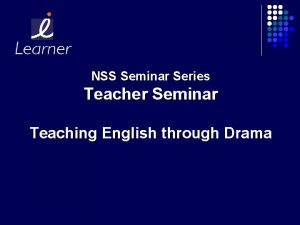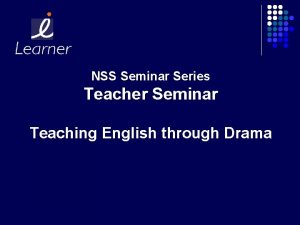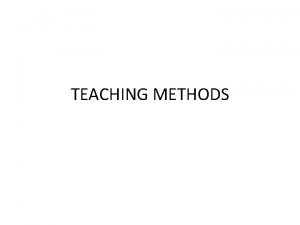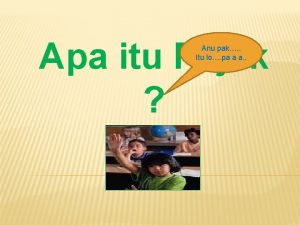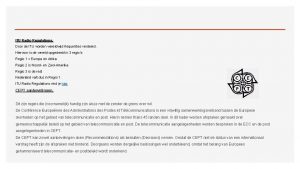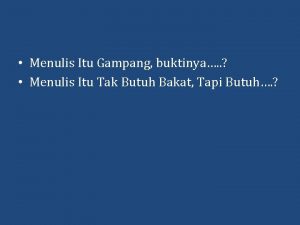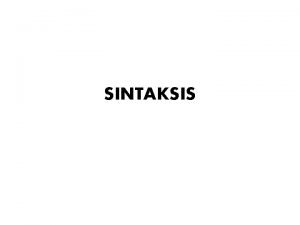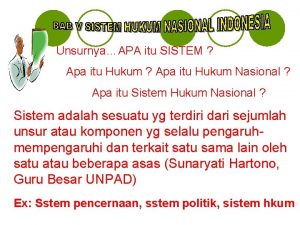ITU Seminar on Teaching Learning ITU Teaching Learning


![Exercise: T "What is good teaching? " [3] Exercise: T "What is good teaching? " [3]](https://slidetodoc.com/presentation_image_h/cc9327cca91bee052df2075ee90d0fb6/image-3.jpg)


![Neighbour Discussion: T "What are the film's main messages (in your opinion)"? [6] Neighbour Discussion: T "What are the film's main messages (in your opinion)"? [6]](https://slidetodoc.com/presentation_image_h/cc9327cca91bee052df2075ee90d0fb6/image-6.jpg)




















![Lecture functional knowledge teacher centric student centric Lecture declarative knowledge [ 27 ] Lecture functional knowledge teacher centric student centric Lecture declarative knowledge [ 27 ]](https://slidetodoc.com/presentation_image_h/cc9327cca91bee052df2075ee90d0fb6/image-27.jpg)





![The Implementation Process [ http: //itucph. onconfluence. com/display/ILU/Study+programme+development ] 1) Think carefully about: overall The Implementation Process [ http: //itucph. onconfluence. com/display/ILU/Study+programme+development ] 1) Think carefully about: overall](https://slidetodoc.com/presentation_image_h/cc9327cca91bee052df2075ee90d0fb6/image-33.jpg)






- Slides: 39

ITU Seminar on Teaching & Learning ITU Teaching & Learning Seminar: Teaching/Learning Activities Claus Brabrand ((( brabrand@itu. dk ))) ((( http: //www. itu. dk/people/brabrand/ ))) Associate Professor, IT University of Copenhagen Denmark ( 09: 00 – 10: 00 )

Introduction to: Constructive Alignment and Intended Learning Outcomes ITU Teaching & Learning Seminar: Teaching/Learning Activities Claus Brabrand ((( brabrand@itu. dk ))) ((( http: //www. itu. dk/people/brabrand/ ))) Associate Professor, IT University of Copenhagen Denmark ( 09: 00 – 10: 00 )
![Exercise T What is good teaching 3 Exercise: T "What is good teaching? " [3]](https://slidetodoc.com/presentation_image_h/cc9327cca91bee052df2075ee90d0fb6/image-3.jpg)
Exercise: T "What is good teaching? " [3]

Outline n 1) Introduction Constructive Alignment n The SOLO Taxonomy n n 2) From Content to Competence Advocate a shift in perspective n Elaborate The SOLO Taxonomy n n 3) Intended Learning Outcomes How to use Intended Learning Outcomes n Relation to new Danish Grading Scale n [4]

Introduction to…: n Constructive Alignment & SOLO Taxonomy: John Biggs’ popular and heavily cited book: “Teaching for Quality Learning at University - What the student does” Note: 3 rd Edition now available [J. Biggs & C. Tang, 2009] “Teaching & Understanding” 19 min award-winning short-film on Constructive Alignment (available on DVD in 7 languages, epilogue by John Biggs) [5]
![Neighbour Discussion T What are the films main messages in your opinion 6 Neighbour Discussion: T "What are the film's main messages (in your opinion)"? [6]](https://slidetodoc.com/presentation_image_h/cc9327cca91bee052df2075ee90d0fb6/image-6.jpg)
Neighbour Discussion: T "What are the film's main messages (in your opinion)"? [6]

Outline n 1) Introduction Constructive Alignment n The SOLO Taxonomy n n 2) From Content to Competence Advocate a shift in perspective n Elaborate The SOLO Taxonomy n n 3) Intended Learning Outcomes How to use Intended Learning Outcomes n Relation to new Danish Grading Scale n [7]

From Content to Competence n My old course descriptions (Concurrency 2004): n Given in terms of a 'content description': n Essentially: Goal is…: To understand: deadlock interference synchronization. . . This is a bad idea for two reasons. . . ! [8]

Problem 1 ! n Problem with 'content' as goals ! analyse. . . compare. . . analyze systems explain causes nt eme agre a from ion dge it owle ed trad nt t kn s taci rch-ba y stude a b rese known not define deadlock describe solutions Goal is…: Teacher analyze systems explain causes Stud. C To understand: deadlock interference synchronization. . . name solutions recite conditons Stud. B Stud. A Censor [9]

Problem 2 ! n Problem with 'understanding' as goals ! Goal is…: To understand: deadlock interference synchronization. . . 'concept of deadlock' ? ! The answer is simple: It cannot be observed ! [ 10 ]

Competence ! n 'Competence' as goals ! n Competence : = knowledge + capacity to act upon it Have the student do something; and then "observe" the product and/or process Objective ! To learn how to: analyze systems for. . . explain cause/effects. . . prove properties of. . . compare methods of. . . Note: 'understanding' is of course pre-requisitional ! Note': inherently operational (~ verbs) 'SOLO' = Structure of the Observed Learning Outcome [ 11 ]

SOLO Advantages n Advantages of The SOLO Taxonomy: Linear hierarchical structure n Aimed at evaluating student learning n Converges on research (at SOLO 5) n Research: Production of new knowledge [ 12 ]

Note: the list is non-exhaustive Graphic Legend SOLO (elaborated) QUANTITATIVE QUALITATIVE SOLO 2 SOLO 3 SOLO 4 ”uni-structural” “multi-structural” “relational” define identify count name recite paraphrase follow (simple) instructions … Q R combine structure describe classify enumerate list do algorithm apply method … Q R problem / question / cue known related issue - given! hypothetical related issue - not given! R student response Q QUALITATIVE SOLO 5 “extended abstract” analyze compare contrast integrate relate explain causes apply theory (to its domain) … Q R theorize generalize hypothesize predict judge reflect transfer theory (to new domain) … Q R R' [ 13 ]

Outline n 1) Introduction Constructive Alignment n The SOLO Taxonomy n n 2) From Content to Competence Advocate a shift in perspective n Elaborate The SOLO Taxonomy n n 3) Intended Learning Outcomes How to use Intended Learning Outcomes n Relation to new Danish Grading Scale n [ 14 ]

Concrete Recommendations (4 x) Intended Learning ulation': 1) Use 'standard form on the student s cu fo ng ni ar le ts pu a) ation: "to be able to" Outcomes b) competence formul[Genetics 101] After the course, the students are expected to be able to: locate V genes. N on chromosomes do V simple calculations N: (e. g. , recombination frequencies, id 'understanding-goals': 4) Avo "To understand X", in-breeding coefficients, Hardy-Weinberg, "Be familiar with Y", evolutionary equilibria). e a notion of Z", . . . ! describe V and perform V connexion-analysis"Hav N describe V fundamental genetic concepts N : (e. g. , mutation variation, in-breeding, natural selection). describe V and analyze V simple inheritancies N analyze V inheritance N of multiple genes simultaneously 2) List ILO's as 'bullets': Clearer than text Student "learning checklist" Use to design Teaching/Learning Activities (TLA's) Use to design Assessment Tasks (AT's) 3) Use 'Verb + Noun' formulation: What the student is expected to do V with a given matter N. [ 15 ]

The Danish Grade Scale For an excellent performance which completely meets the course objectives, with no or only a few insignificant weaknesses. A For a very good performance which meets the course objectives, with only minor weaknesses n o i t a z i l a e r f Good o ! s e e e v r i g t e c e D j = b : o e e d s r Fairra u o G c of B For a good performance which meets the course objectives but also displays some weaknesses C For a fair performance which adequately meets the course objectives but also displays several major weaknesses D 02 Adequate For a sufficient performance which barely meets the course objectives E 00 Inadequate For an insufficient performance which does not meet the course objectives Fx -3 Unacceptable For a performance which is unacceptable in all respects F 12 Excellent 10 7 4 Very good [ 16 ]

T Activation Exercise What are key ILO's in YOUR course ? Concurrency: analyze systems compare models [ 17 ]

Questions. . . R Q R' Association new ~ old ert Susan & Rob Course descriptions My research ing" "understand teaching and e c mpeten content co models Teacher 2 -3 levels 1 - The Short-Film The Book 'TLA' Teaching / Learn ing Activities Cognitive proce ss es The SOLO Taxo nomy ? Students at University ? " g od teachin o "What is g Student activ ation Tips'n'Tricks MAT CS v. NAT v. s John Bigg 15% programm Top Competence ing s recite generalize Constructive Alignment [ 18 ]

From Intended Learning Outcomes to Teaching/Learning Activities ITU Teaching/Learning Seminar: Teaching/Learning Activities Claus Brabrand ((( brabrand@itu. dk ))) ((( http: //www. itu. dk/people/brabrand/ ))) Associate Professor, IT University of Copenhagen Denmark ( 10: 30 – 10: 45 )

From ILO's to TLA's ITU Teaching/Learning Seminar: Teaching/Learning Activities Claus Brabrand ((( brabrand@itu. dk ))) ((( http: //www. itu. dk/people/brabrand/ ))) Associate Professor, IT University of Copenhagen Denmark ( 10: 30 – 10: 45 )

Summary from Last Year Constructive Alignment and Intended Learning Outcomes

Intended Learning Outcomes n From content: n n Goal: understand: deadlock interference synchronization. . . analyze explain name recite vs. Teacher Student Understanding? !? . . . to competence: n n ILO's: analyze. . . explain. . . compare. . . apply. . . Have the student do something; and then "observe" product and/or process Intended Learning Outcomes (using verbs from The SOLO Taxonomy) [ 22 ]

Constructive Alignment § Make explicit ILO's Teaching § Learning = ILO's = Activities ( Intended Learning Outcomes ) Assessment § (…and tell this to students) vs. SUSAN: intrinsically motivated ROBERT: extrinsically motivated [ 23 ]

The Implementation Process 1) Think carefully about: overall goal of course (what are the stud. to learn? ) 2) Operationalize these goals: and express them as (SOLO) intended learning outcomes learning support alignment 3) Carefully design (TLA's): teaching/learning actitivites ( intended learning outcomes) More information on implementing alignment: learning incentive 4) Carefully design (AT's): assessment tasks ( intended learning outcomes) [ http: //www 1. itu. dk/sw 79909. asp ][ 24 ]

Teaching/Learning Activities General issues

Lecture n Teacher activity: n n n n [ Biggs & Tang 2007, p. 137 ] n (about Application) vs. Student activity: n Introduce Explain Elaborate Discuss application Give examples Show PPT slides Questions on slides Winding up n n n n Listen (maybe take notes) Understand? (correctly? deeply? ) Listen (maybe take notes) Watch (maybe note points) Write answers to questions Possibly ask a question active teacher vs. passive student [ 26 ]
![Lecture functional knowledge teacher centric student centric Lecture declarative knowledge 27 Lecture functional knowledge teacher centric student centric Lecture declarative knowledge [ 27 ]](https://slidetodoc.com/presentation_image_h/cc9327cca91bee052df2075ee90d0fb6/image-27.jpg)
Lecture functional knowledge teacher centric student centric Lecture declarative knowledge [ 27 ]

Student Activation "The (in-famous) Learning Pyramid": Average retention rate active student Listening: Learning about s ac tud tiv en at t io n passive student Doing: Learning to do Lecture 5% Reading 10% Audiovisual 20% Demonstration 30% Discussion group 50% Practice by doing 75% Teaching others 80% [ NTL Institute for Applied Behavioral Science, Bethel, Maine ] [ 28 ]

Listening n vs. Doing Learning (about): n n n n n about application about cooking about programming about designing about analysis about construction about relating. . . Learning (to do): n n n n to apply to cook to program to design to analyse to construct to relate. . . student listening (to something about something) vs. student doing !! [ 29 ]

Main Point !!! n Given (carefully chosen): ILO's: analyze. . . explain. . . compare. . . apply. . . student-centric Design TLA's = ILO's FOCUS TODAY! Note: there is a workshop on this later today (17: 35 - 18: 20) [ 30 ]

Thank you ! Have a great seminar !

WORKSHOP: Aligning your TLA's with your ILO's ITU Teaching/Learning Seminar: Teaching/Learning Activities Claus Brabrand ((( brabrand@itu. dk ))) ((( http: //www. itu. dk/people/brabrand/ ))) Associate Professor, IT University of Copenhagen Denmark ( 17: 35 – 18: 20 )
![The Implementation Process http itucph onconfluence comdisplayILUStudyprogrammedevelopment 1 Think carefully about overall The Implementation Process [ http: //itucph. onconfluence. com/display/ILU/Study+programme+development ] 1) Think carefully about: overall](https://slidetodoc.com/presentation_image_h/cc9327cca91bee052df2075ee90d0fb6/image-33.jpg)
The Implementation Process [ http: //itucph. onconfluence. com/display/ILU/Study+programme+development ] 1) Think carefully about: overall goal of course ILO's: (what are the stud. to learn? ) analyze systems for properties (e. g. deadlock) compare models of systems (wrt. behavior) 2) Operationalize these goals: and express them as (SOLO) intended learning outcomes learning support 3) Carefully design (TLA's): teaching/learning actitivites ( intended learning outcomes) alignment learning incentive 4) Carefully design (AT's): assessment tasks ( intended learning outcomes) [ 33 ]

Workshop (groups of 3) 1) Pair up (groups of 3) and choose 1 -2 key ILO's from your courses: n (e. g. , 'to program', 'to design', 'to construct', 'to analyse', 'to relate', 'to compare', . . . ) 2) Design a student-centric TLA for those key ILO's n 30' (relating today's material to your teaching) 3) Pair up with another group and explain your TLA n 5' 2 x 5' (just explain the main points and the student-centricity) Exercise on "Teaching/Learning Activities" (From ILO's to TLA's) ITU, Nov 20, 2009 [ 34 ]

BONUS SLIDES -=-

Key References n ”Teaching for Quality Learning at University” John Biggs & Catherine Tang Society for Research into Higher Education, 2007. Mc. Graw-Hill. n ”Evaluating the Quality of Learning: The SOLO Taxonomy” John Biggs & Kevin F. Collis London: Academic Press, 1982 n ”Teaching & Understanding” Claus Brabrand & Jacob Andersen 19 minute award-winning short-film (DVD) Aarhus University Press, Aarhus University, 2006 n "Constructive Alignment & The SOLO Taxonomy: a Comparative Study of University Competencies in Computer Science vs. Mathematics" Claus Brabrand & Bettina Dahl CRPIT, Vol. 88, ACS 3 -17, R. Lister & Simon, Eds. , 2007 [ 36 ]

Common SOLO Competences From a study of 632 x courses at NAT/(AU+SDU) ie. science context [ 37 ]

The BLOOM Taxonomy (1956) The BLOOM Taxonomy: Synthesis Evaluation ive SOLO Analysis 2+3 Quan Application titative SOLO at Qualit 4+5 n Comprehension Knowledge ” ”[…] really intended to guide the selection of items for a test rather than to evaluate the quality of a student’s response to a particular item” -- (Biggs & Collis, 1982) [ 38 ]

Constructive Alignment TLA's ILO's AT's (Teaching/Learning Activities) (Intended Learning Outcomes) (Assessment Tasks) Designed to meet ILO's Explicitly defined and communicated Designed to assess ILO's learning support learning incentive [ 39 ]
 Seminar teaching method
Seminar teaching method Cuadro comparativo entre e-learning b-learning y m-learning
Cuadro comparativo entre e-learning b-learning y m-learning Microteaching definition
Microteaching definition Apa itu teaching at the right level
Apa itu teaching at the right level Appetitive faculties
Appetitive faculties New jersey center for teaching and learning
New jersey center for teaching and learning How many total squares are there
How many total squares are there Guiding principles for teaching and learning in mtb-mle
Guiding principles for teaching and learning in mtb-mle Lausd teacher framework
Lausd teacher framework Inspired learning placement
Inspired learning placement Assessment the bridge between teaching and learning
Assessment the bridge between teaching and learning Technical core meaning
Technical core meaning Educational cds for adults
Educational cds for adults Approaches to teaching and learning ib
Approaches to teaching and learning ib New jersey center for teaching and learning
New jersey center for teaching and learning Development of teaching learning materials
Development of teaching learning materials 10 steps to independence daily 5
10 steps to independence daily 5 Impact of assure model to students
Impact of assure model to students What is contextualized learning
What is contextualized learning Peek model for readiness to learn
Peek model for readiness to learn Transparency in learning and teaching
Transparency in learning and teaching Nj center for teaching and learning
Nj center for teaching and learning Contextual teaching and learning
Contextual teaching and learning![Creative teaching u0026 learning [open house sit lhi] Creative teaching u0026 learning [open house sit lhi]](data:image/svg+xml,%3Csvg%20xmlns=%22http://www.w3.org/2000/svg%22%20viewBox=%220%200%20200%20200%22%3E%3C/svg%3E) Creative teaching u0026 learning [open house sit lhi]
Creative teaching u0026 learning [open house sit lhi] Styles of learning and teaching
Styles of learning and teaching Taylor institute for teaching and learning
Taylor institute for teaching and learning Define computer assisted language learning
Define computer assisted language learning Apa itu integrated learning
Apa itu integrated learning What makes a good college application
What makes a good college application Smart note taker seminar report
Smart note taker seminar report Miami pediatric nephrology seminar
Miami pediatric nephrology seminar Ap seminar memes
Ap seminar memes W seminar präsentation
W seminar präsentation Buck boost transformer seminar report
Buck boost transformer seminar report Iwa minimum word count
Iwa minimum word count Level 3 questions examples
Level 3 questions examples The outsiders socratic seminar questions
The outsiders socratic seminar questions Contoh sop kegiatan seminar
Contoh sop kegiatan seminar Socrates way of teaching
Socrates way of teaching Socratic seminar definition
Socratic seminar definition
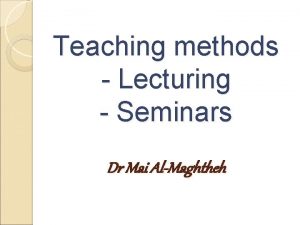


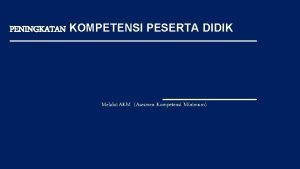
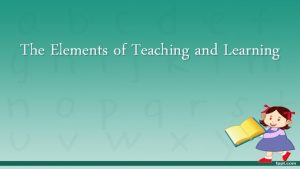



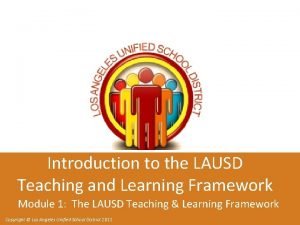
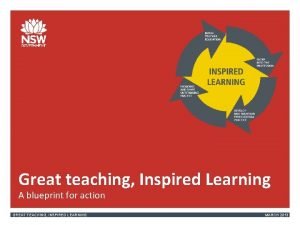
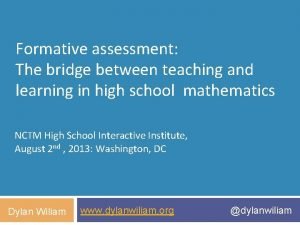
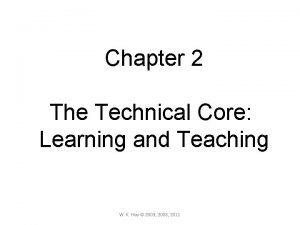
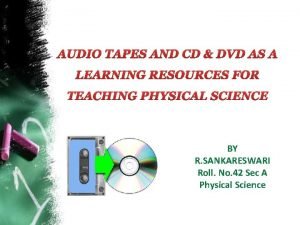
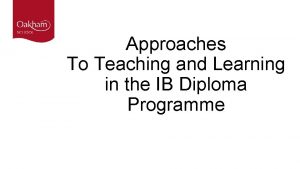


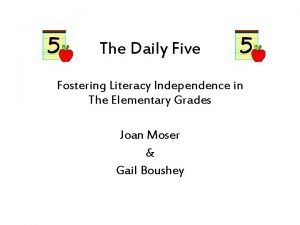

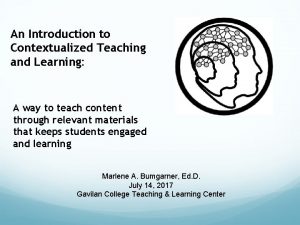
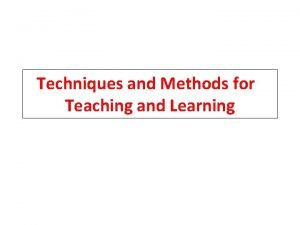
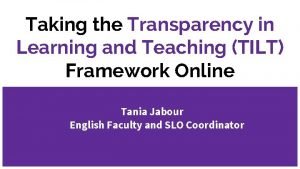
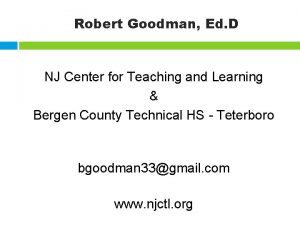
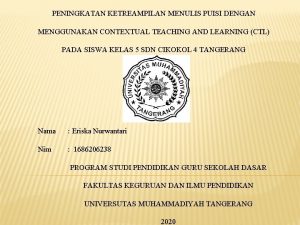
![Creative teaching u0026 learning [open house sit lhi] Creative teaching u0026 learning [open house sit lhi]](https://slidetodoc.com/wp-content/uploads/2020/11/2512431_988e0f6fb16141d8d362e3669c9f87c2-300x225.jpg)
